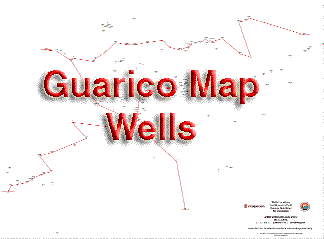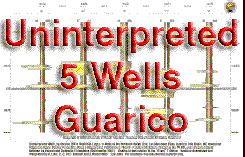|
EXERCISE
4
Objectives
The purpose of this exercise is to enable you to:
Data
- The illustrative
data to be used for the exercise have been saved either in .pdf,
.gif and/or .jpg format. These maps and cross-sections can be
viewed and interpreted with a variety of different visualization
software (including but not exclusive of Adobe Acrobat, Adobe
Illustrator, Freehand, Canvas and/or Photoshop) or printed on
a large frame plotter and interpreted by hand. These exercise
illustrations are quite large (up to 500K in some cases) and they
may take a little time to be displayed. Patience will be rewarded!!!!
- The clickable map
below is linked to a pdf file which locates the five wells (me333,
me296, me428, me313
and me 486) within the central portion of the
Northern Strike Line

- As an alternative this map can also be viewed by clicking on
the link to a large .jpg
file
- Use the Spontaneous
Potential and Resistivity
logs displayed on the .pdf file of the cross section 5 wells Guarico
linked to the clickable thumbnial.

- As an alternative the above .pdf file this cross section can
also be viewed by clicking on the link to a large .gif
file
- You can also view and/or print a smaller version of these files
by using your vizualization software to shrink the images to fit
your printer.
- A report describing
the high-frequency (fourth-order cycles) sequence stratigraphy
and regional geology of this region is provided in the
geologic setting of the La Pascua Formation,
the
introduction to the sequence stratigraphy of the La Pascua Formation
and the eustatic
chart.
- A set of maps of previously
interpreted wells is also provided to enable the construction
of sand thickness isopachs for each of the intervals. Please refer
to the basemap
for the location of all the wells.
Methods
Utilize the Gulf
Coast slip-slide method to help you match the log sections
and identify the same geologic events on the various wells.
Provide an overall analysis
that describes your conclusions.
As with the earlier three exercises (Exercise
1, Exercise 2 and
Exercise 3) to help with
your interpretation of the well logs you should both view the movies
and read the earlier sections related to the
geologic setting of the La Pascua Formation
and the introduction
to the sequence stratigraphy of the La Pascua Formation. From these you
will gain knowledge of the depositional setting of these rocks.
You should combine the techniques outlined above with your understanding
of the regional geology and the vertical and lateral facies relationships
in near shore clastic settings (eg. shoreline,
beach,
stacked
beaches, tidal
flats,
deltas) and Walther's
Law. You should use these to build a depositional model and
a sequence stratigraphic interpretation of the well log section.
|




